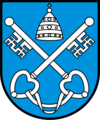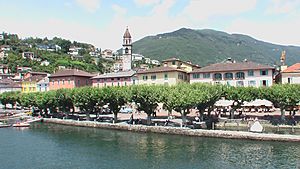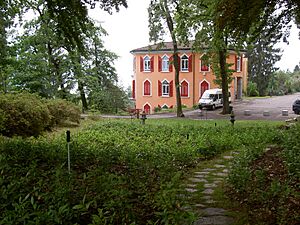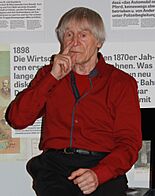Ascona facts for kids
Quick facts for kids
Ascona
|
||
|---|---|---|
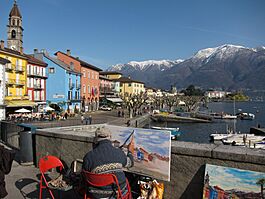 |
||
|
||
| Country | Switzerland | |
| Canton | Ticino | |
| District | Locarno | |
| Area | ||
| • Total | 4.95 km2 (1.91 sq mi) | |
| Elevation | 196 m (643 ft) | |
| Population
(Dec 2020 )
|
||
| • Total | 5,554 | |
| • Density | 1,122.0/km2 (2,906/sq mi) | |
| Postal code |
6612
|
|
| Surrounded by | Brissago, Gambarogno, Intragna, Locarno, Losone, Ronco sopra Ascona | |
Ascona (Ticinese: Scona [ˈʃkona]) is a town in Switzerland. It is located in the Ticino region, right on the beautiful shore of Lake Maggiore.
This town is a very popular place for tourists. It also hosts the famous Ascona Jazz Festival every year.
Contents
Discovering Ascona's Past
Ascona has a long and interesting history. People have lived here for thousands of years!
Ancient Times: Early Settlers
The oldest things found in Ascona date back to the late Bronze Age. This was a time long before written history. In 1952, a burial ground was found. It contained 21 urns with burned bones and bronze items. These items included old bronze brooches. They show that Ascona traded with other cultures, even across the Alps.
Later, during the Roman Empire, another burial ground was found. It had 38 tombs. These tombs likely belonged to people living in a nearby Roman villa.
Medieval Ascona: A Growing Town
Ascona was first mentioned as a fortified settlement in 1186. Its name, Sconae, has a mysterious origin. In the Middle Ages, Ascona worked closely with the nearby town of Locarno. Ascona was an important place, even having its own rules by 1369.
Several noble families built castles and homes here. The Duni family expanded their fortress in the 12th and 13th centuries. The Carcani and Griglioni families also built castles. These castles helped protect the town and its port.
Churches were also important. The Church of SS Peter and Paul was first mentioned as a parish church in 1330. Another church, S. Maria della Misericordia, was built later. It has amazing old fresco paintings inside.
Modern Ascona: Changes and Growth
In 1580, a rich man named Bartolomeo Papio gave money to build a seminary in Ascona. This school, called the Collegio Papio, was finished in 1584. It has been rebuilt and expanded many times over the centuries.
The town continued to grow. The Church of SS Peter and Paul was made bigger in the 16th century. The Church of Madonna della Fontana was built in the 17th century. It became a place for people to visit on pilgrimages.
Until the early 1900s, Ascona's economy relied on farming, raising animals, and fishing. Many builders and artists from Ascona also traveled to Italy for work. Later, factories for things like linen and even dynamite provided jobs.
In the 20th century, tourism became very important for Ascona. Many people started buying second homes here. By the end of the 20th century, thousands of visitors came to Ascona each summer. The town grew, and it now connects with Locarno. Ascona even has its own airport, though it might close soon.
Monte Verità: A Place of Ideas
"Monte Verità" means "Mount Truth." It got this name in the early 1900s. A special "colony" was started here by people who believed in simple living and freedom.
This colony attracted many famous artists, thinkers, and writers. People like Hermann Hesse, Carl Jung, and Paul Klee visited or lived here. It was a place where new ideas and ways of life were explored.
Ascona's Location and Landscape
Ascona is located in the Locarno District. It sits on the right side of the Maggia river where it flows into Lake Maggiore. The town includes areas like Gerbi, Monescie, Monte Verità, Moscia, and Saleggi.
About a third of Ascona's land is used for farming. Another third is covered by forests. The rest of the land has buildings, roads, or parks. A small part is rivers or lakes.
Ascona's Coat of Arms
The blazon of Ascona's coat of arms shows two silver keys crossed over each other. Above them is a silver papal crown. These symbols represent Saint Peter and were given to Ascona by the Bishop of Como. This happened when the bishop and the church of St. Peter gave Ascona feudal rights.
People of Ascona
Ascona has a population of over 5,500 people. Many people who live here are from other countries.
Most people in Ascona speak Italian. German is the second most common language.
The population of Ascona has grown a lot over the years. In 1591, about 1,000 people lived here. By 2017, the population was over 5,500.
Important Buildings and Sites
Ascona has several important heritage sites. These are places that are very important to Switzerland's history and culture.
- The Church of S. Maria della Misericordia and the Collegio Papio
- The Church of S. Michele with its old castle ruins
- The Parish Church of SS. Pietro e Paolo
- Historic houses like the Serodine House
- The Balladrum, an ancient settlement site
- The Albergo, a park with a group of houses
- The Monte Verità Museum
- Art museums like the Museo comunale d’arte and the Museo Epper
- The Teatro S. Materno theater
The entire town of Ascona is listed as a Swiss Heritage Site.
Ascona's Economy
Ascona's economy is mostly based on the service industry. This includes things like hotels, restaurants, and shops. Many people work in the tourism sector.
In 2009, Ascona had 34 hotels with many rooms and beds for visitors. A lot of people travel to Ascona for work, and many residents also work in other towns.
Religion in Ascona
Most people in Ascona are Roman Catholic. A smaller number belong to the Swiss Reformed Church.
Learning in Ascona
Education is important in Ascona. Many adults have completed higher education.
The local education system offers kindergarten, primary school, and secondary school. Students can choose different paths, including vocational training or programs that prepare them for university.
Famous People from Ascona
Ascona has been home to many interesting people:
- Dimitri (1935–2016), a famous Swiss clown and mime artist.
- Daniela Ambrosoli (born 1941), a Swiss businesswoman and film director.
- Bruno Bisang (born 1952), a Swiss fashion photographer.
- Paolo Duca (born 1981), a former Swiss ice hockey player.
- Brigitte Helm (1906–1996), a German actress who lived in Ascona.
- Gaetano Matteo Pisoni (1713–1782), an Italian architect.
- Marianne von Werefkin (1860–1938), a Russian-German-Swiss painter who lived in Ascona.
Images for kids
See also
 In Spanish: Ascona para niños
In Spanish: Ascona para niños


